Today we’re exploring movie props & memorabilia.
Given that the Oscars are next week, we wanted to find out what happens to these assets after filming. This is a fun issue, packed with entertaining stories and facts.
Table of Contents
Introduction
Next week, the Oscars will hit our TVs for the 94th time.
Oh, what’s that? You didn’t know?
Well, you’re not alone. Oscar ratings have been declining for years, especially as covid shut down theaters and streaming eats the world. Last year’s Academy Awards was the lowest-watched ever, dropping a shocking 59% YoY.
But while movies no longer occupy the center of pop culture, and the way we watch them has changed, film culture will never go away. And there’s no doubting the Oscars’ prestige within the industry.
Did you know that people have actually bought and sold the famous bronze-gold statues?

Interestingly, back in 1950, the Academy was getting upset that people were selling them. So a new rule was introduced to combat these trophies becoming collectibles.
Recipients cannot sell their awards unless they offer to sell them back to the Academy for one dollar. But awards handed out before then? Fair game!
Who buys Oscars?
Steven Spielberg regularly purchases vintage Oscars. In 2001 he paid $578k in 2001 to nab Bette Davis’ 1938 Best Actress award. He also picked up Clark Gable’s Oscar for starring in 1934’s It Happened One Night for $607k.
But instead of keeping them, Spielberg donates Oscars back to the Academy to preserve film history.
The late Michael Jackson plopped down over $1.5 million to acquire the Best Picture Oscar for Gone with the Wind. After Jackson’s death, his estate has no idea what happened to it. And at least 75 Oscars awarded since 1950 have been illegally sold on the black market.
But when it comes to investing in movie memorabilia, the Oscars are just the tip of the iceberg. All sorts of amazing stories accompany the sale of famous props, from James Bond’s gun to Judy Garland’s slippers in The Wizard of Oz.
What happens to movie memorabilia?
When you hear the term ‘movie memorabilia,’ you probably think of props. In reality, anything with cinematic ties is considered memorabilia, including scripts, promo posters, costumes, and even entire sets.
After filming wraps, the producer and studio generally decide what happens to all these assets.
Typically goods are:
- Sent to a warehouse owned by the studio (many props are re-used)
- Publicly auctioned off
- Sold to private collectors
- Housed by the production designer
- Donated to a museum
- Shipped to another film set
- Sold to a restaurant or theme park
- Given to the actors
- Trashed
What movie memorabilia can you actually buy?
Posters and artwork
Artwork memorabilia includes promo posters, signed photographs and even art used as a prop.
These are typically some of the cheapest authentic film memorabilia you can buy, though even posters and 1 of 1 signed images can still set you back thousands.
Lately, we’ve been exploring the cool world of alternative film posters. A few months ago, Heritage held an alt film poster auction with some real treats to be found.

Here’s what Heritage has to say about alt film posters:The Alternative Movie Poster has emerged as a cutting-edge collectible with a rapidly growing base of artists, collectors and galleries. Many modern collectors have discovered that the alternative images on these posters are vastly superior to the traditional images created by the film studios to promote their films. Part pop culture and part fine art, these high quality, limited-edition prints feature the art of some of the most renowned commercial and comic art illustrators working today.
And a week before Heritage, the industry saw perhaps the biggest sale of movie posters ever. An auction hosted by European Prop Store, one of the world’s leading film and TV memorabilia companies, had over 750 exclusive posters up for grabs, bringing in $500k in sales.
Notable pieces included:
- Concept artwork for Star Wars: The Empire Strikes Back, created by Josh Kirby. This was expected to rake in ~$9,000. However, bidding heated up and the piece sold for $58,554.

- An original 1978 Star Wars poster, wishing its recipient a happy first birthday, was sold for $5,500. I wonder if the cake from the photo is still around…
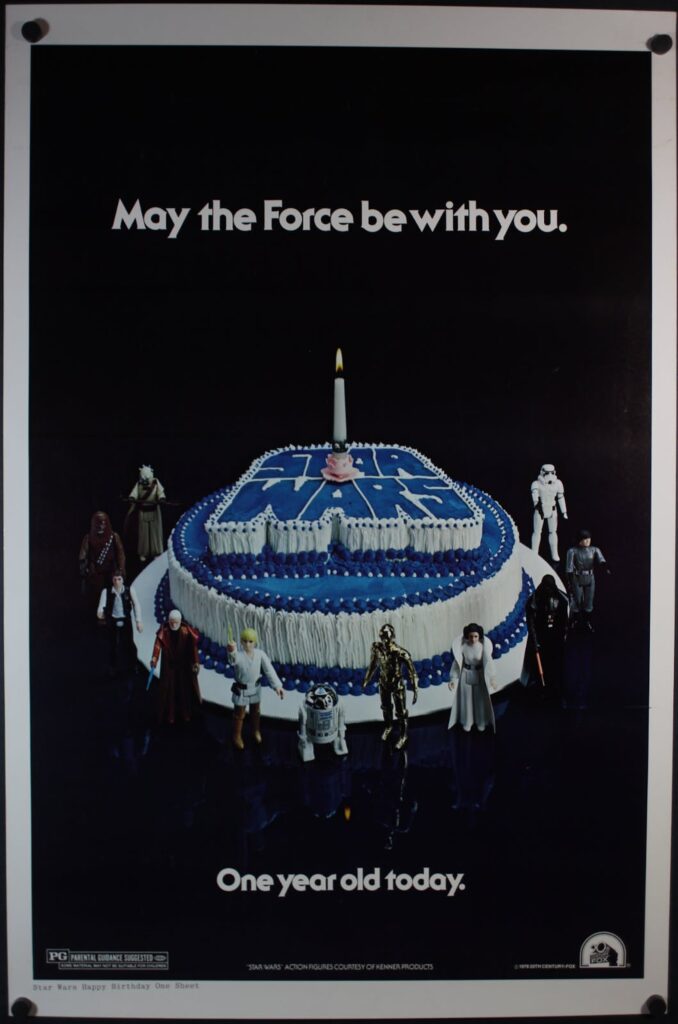
If these have piqued your interest, another auction for rare movie posters is happening on March 24th. Of the 550-strong collection, over 60 feature artwork from Star Wars. (Noticing a trend here?)
But Force-related posters aren’t the only pieces making bank in the film memorabilia scene. Casablanca, widely considered one of the most influential movies ever made, is also home to movie posters’ creme de la creme.
According to experts, just one single edition of the 1942 Italian-issued promo poster for the film still exists, and its price reflects its rarity. At a 2017 auction, it sold for $487,000.

DVD box sets
Single DVDs are pretty easy to purchase and don’t have much value. But box sets can.
- A collector’s box-set of Lord of the Rings still retails for about $500. If you want to grab the 30-disc set on Blu-Ray (remember that?) you’re looking at $2,000 💍
- The Harry Potter Wizard’s Collection is a 19-pound beast that fetches $1,300 ⚡
Props and costumes
Alright, this is the big one. Movie props are some of the most sought-after collectibles by fans and investors alike, and for good reason – they can be worth millions.
Let’s take a look at some of the most expensive, quirky, and craziest movie props ever sold.
The Wizard of Oz
Oz is one of the most well-known films ever made. No matter which generation you’re from, chances are you’ve seen it. Being such a seminal part of movie culture, it’s not a shock to learn that it is still making waves in the memorabilia scene 8 decades after its release.
Everyone remembers the Cowardly Lion, right? Well, I bet you didn’t know that his costume was actually created out of real lion hide.
Because it’s pretty difficult (not to mention unethical) to construct two identical suits out of lion fur, they used the same costume throughout shooting for the entire film.
The thing is, lion fur isn’t exactly light. The costume was so dense and heavy that it had to be placed in an industrial drying bin every night just to dry out the actor’s sweat.
Despite its murky (and moist) past, the prestige of The Wizard of Oz meant the costume still sold at auction for over $3 million dollars back in 2014.

The most recognizable asset from the film, though, is Dorothy’s famous red slippers. Unlike the lion costume, these were not exclusive, and a few pairs exist.
The first notable sale took place in 1970, when they were purchased at an MGM auction for $15,000 (about $110,000 in today’s dollars, a figure that was unprecedented at the time).
One crazy place a pair turned up was with a teenage girl named Roberta Bauman. In 1939, she won a promotional set of the slippers by getting second place in a contest. They got passed around, and fifty years later, the very same pair was auctioned off by Christie’s for $165,000.

Wilsoooooon! 🏐
Last year, the Volleyball from Castaway (aka “Wilson”) sold at auction for $311k — about 4x what it was expected to go for.
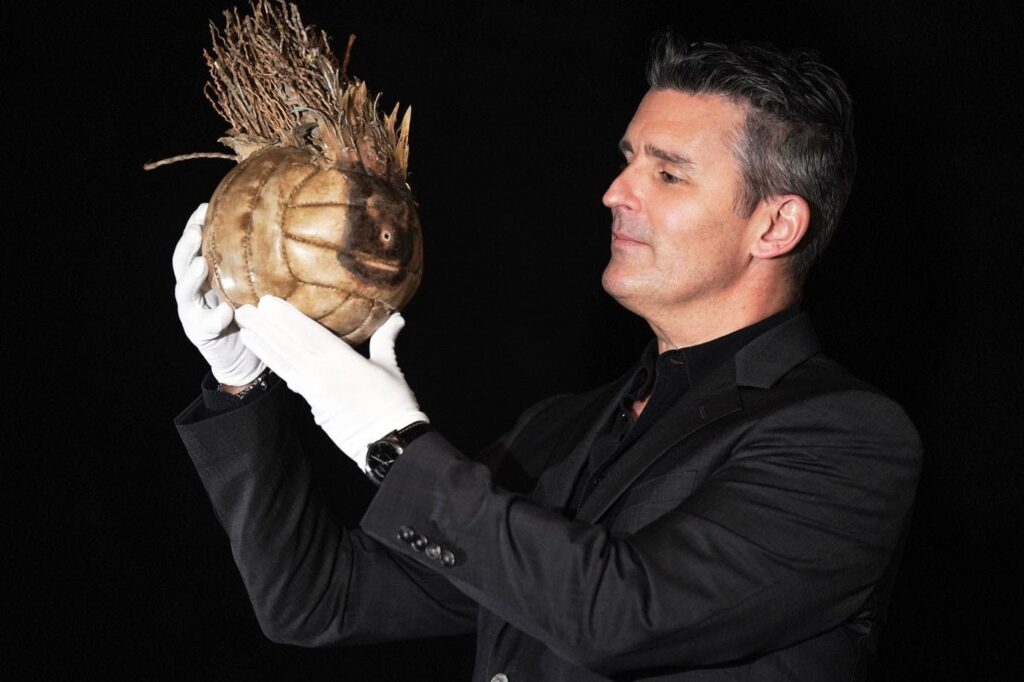
The ball was sold through PropStore, one of the most popular and trusted authorities in movie memorabilia. PropStore has also auctioned Will Ferrell’s Elf costume ($295k), and Harry Potter’s glasses and wand.
Debbie Reynolds
Debbie Reynolds is one of Hollywood’s most famous actresses. She appeared in everything from Singin’ in the Rain to TV hit Will & Grace. In 2016 she passed away exactly one day after her daughter, Carrie Fisher from Star Wars.
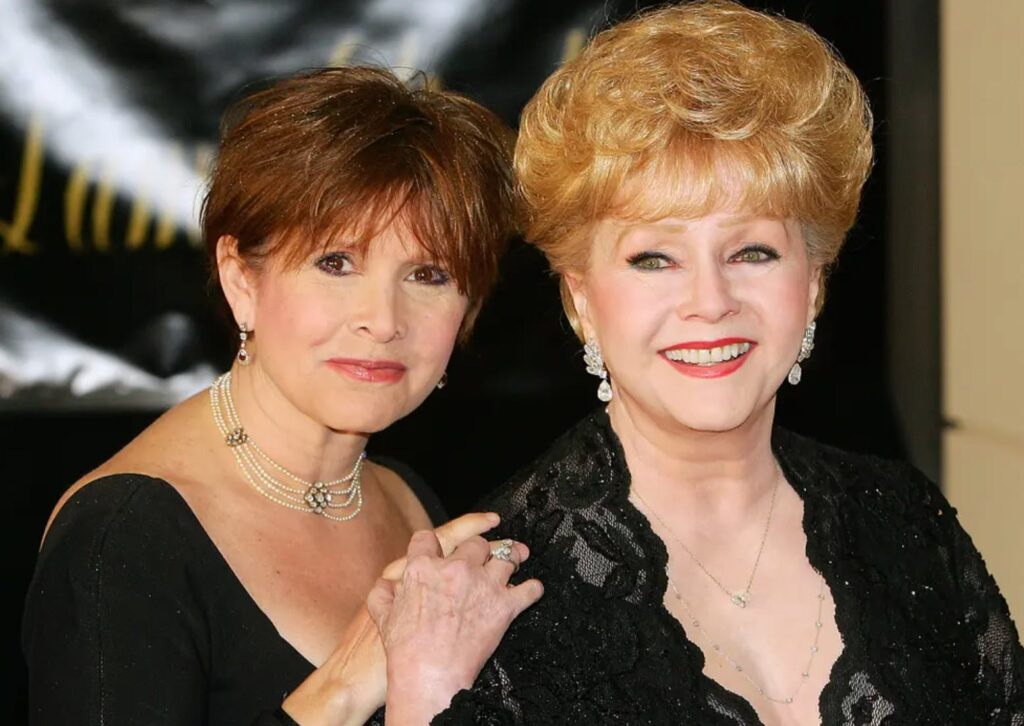
But what Debbie was really known for was being one of the world’s top collectors of movie memorabilia, with a goal of preserving film culture for generations to come.
Her collection includes:
- Audrey Hepburn’s My Fair Lady dress. Reynolds purchased it in the 90s for $100k. In 2011, she flipped it at auction for $4.5 million – not bad!
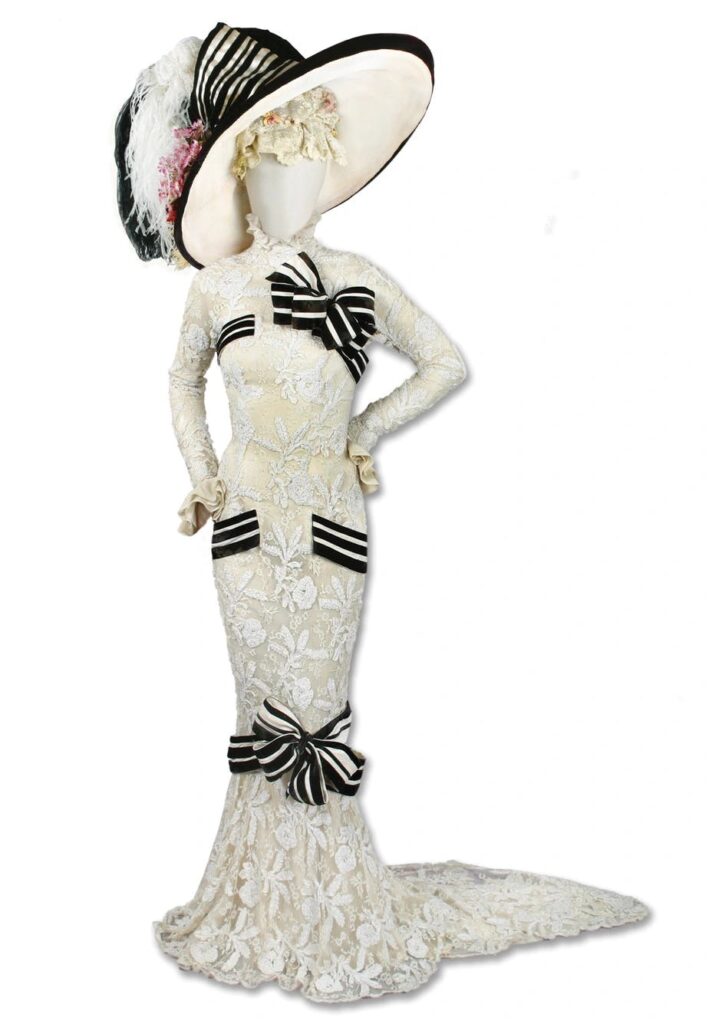
- Marilyn Monroe’s famed “subway dress,” which was raised on the side due to the wind of a passing-by train. This was Reynolds’ prized piece. She held her own auction for it, and sold in 2011 for $5.6 million – blowing away the $1m pre-auction estimate.

- At a 1970 MGM auction, Reynolds went hard, acquiring thousands of items worth $180k ($600k today) One such item was a full-sized sailing ship from Mutiny on the Bounty.
- She owned a suit of armor used in Victor Fleming’s Joan of Arc.
- Tom Hanks’ original Bubba Gump shrimp captain outfit from Forrest Gump, which she auctioned off for $1,200.
- A bunch of Star Wars stuff signed by Carrie Fisher (obviously)

Reynolds claimed that she attempted to collaborate with the Academy of Motion Picture Arts on five separate occasions to create a museum preserving some of these famous props. They declined each time, so Reynolds gave up and sold most of her collection.
When asked why she gave up, she replied: “I still have a lot of my things, but I decided to become rich.”
Fair enough!
After she died, many wanted to bring her museum idea to life, and thought her LA dance studio would be the perfect spot. But it was sold and demolished. So much for that idea 🤷♀️
Other wacky sales
Sound stages
Circling back to the 1970 MGM auction that revolutionized collecting movie memorabilia, one of the most insane items auctioned was purchased by David Weisz for $1.5 million.
What did he buy?
He bought seven entire sound stages, complete with an array of props and items.
Weisz got a heck of a deal. His investment included:
- Over 350,000 costumes
- Custom-designed furniture
- Full-sized cars, buses, trains
- A full-sized prop tank (didn’t fire, but extremely realistic)
- Space capsules (fake but cool)
Walter White’s undies
The (used) underwear that Bryan Cranston’s character Walter White wore in the famous pilot of the AMC series sold for a tremendous $9,900 as part of an auction for the show’s props.
Other notable sales from the auction include Hector Salamanca’s bell ($12,250) and the charred Pink Teddy Bear ($4,300)

Trump gets outbid at auction
Back in 1988, long before he entered politics, Donald Trump was at a Sothebys auction bidding on the small 58-key piano featured in Casablanca. But he left the auction empty-handed.
The winner was an anonymous Japanese bidder who paid $154,000. 25 years later, the piano sold again, this time for $3.4 million.
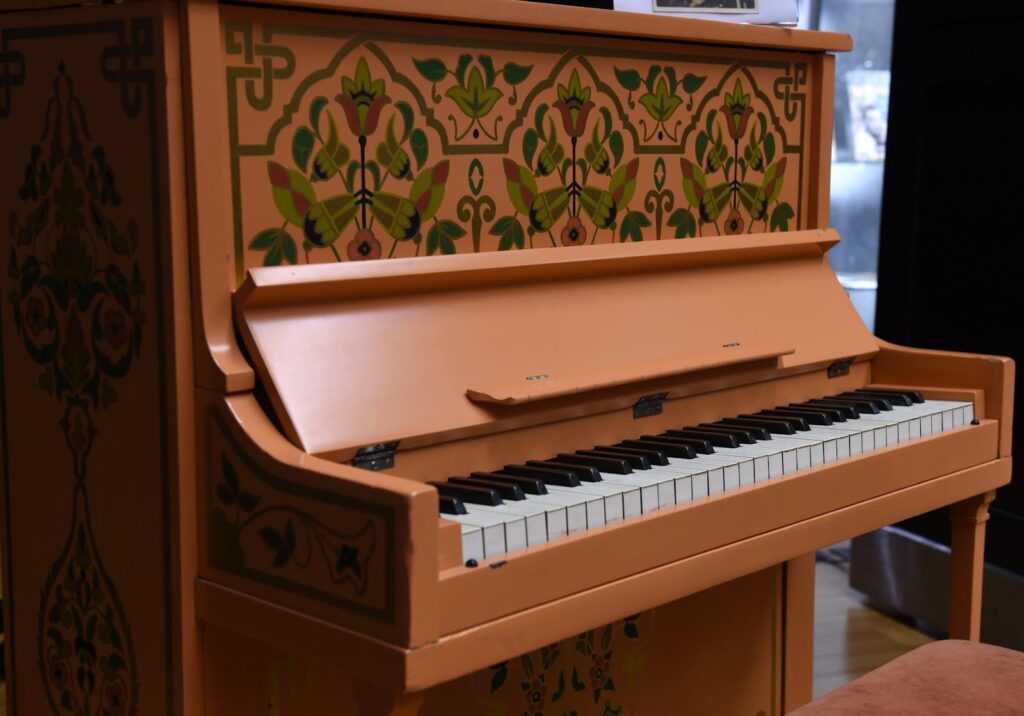
Stolen Bond guns
On March 23, 2020, just as the pandemic was kicking into full gear, five guns used by James Bond were stolen from an avid collector in London.
The deactivated guns were:
- Beretta auto pistol, used in Die Another Day (2002)
- Walther PPK pistol, used in A View to a Kill (1985)
- Smith & Wesson Magnum Revolver, used in Live and Let Die (1973)
- Beretta ‘Tomcat’ pistol with a silencer, also used in Die Another Day
- Llama .22 caliber pistol (which was actually recovered in a random field just a few weeks later)

Pulp Fiction ride
Perhaps the highest-profile theft is the 1964 Chevy Malibu SS from Pulp Fiction (1994).
The vehicle they used in the film was actually owned by Quentin Tarantino. It’s not very often a filmmaker offers their own ride for shooting.
After Pulp Fiction was released, the car was stolen outside of Tarantino’s LA home. After going missing for twenty years, it was finally recovered in April 2013.

The story of how they found it is crazy. One day, detectives randomly came across a man stripping down a Malibu in Victorville. They noticed the car looked identical to Tarantino’s famous lost car. But the man claimed it was actually his, and had been since the 70s.
Police checked the registration and found that there was actually a second car in Oakland, which had the exact same VIN number as the vehicle they recovered. (Huh?)
The registration for the Victorville Chevy was illegally copied and assigned to the Chevy in Oakland. So highway patrol visited the Oakland property, and guess what they found? Boom. Tarantino’s prized Chevvy Malibu.
However, the new owner wasn’t actually the thief either! It turns out the poor guy had purchased the car from a private collector and spent $40,000 fixing it up. In fact, he had never heard of Tarantino, and has never even seen Pulp Fiction!
Conclusion
So there you have it. Some of the wackiest stories from the wild world of movie memorabilia.
I don’t know what the future holds for this world, but you better believe technology & finance will change the landscape as they have with so much else.
Heck, Tarantino himself is already pushing the boundaries, trying to auction off NFTs of his Pulp Fiction script. He’s in an unprecedented legal battle with Miramax, who claims they’re the true owners. But Tarantino isn’t backing down, and the implications for Hollywood are pretty big.
In the meantime, here at Alts we’re bullish as hell on film memorabilia, and expect to allocate to it in our first fund (launching very, VERY soon). Sure, nobody watches the Oscars anymore. But just like movies themselves, memorabilia is emotional, fun, timeless, and rare.
What’s not to love?
🎬












